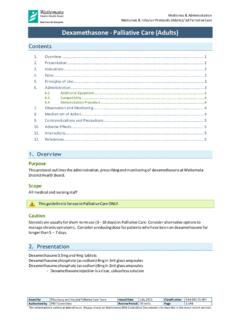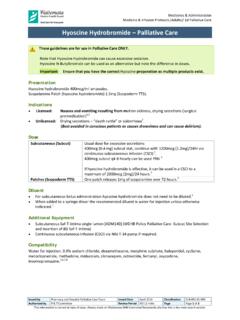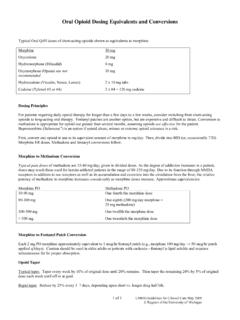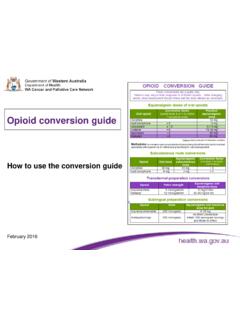Transcription of [P] Fentanyl Subcutaneous & Nasal - Palliative Care (Adults)
1 Medication & Administration Medicines & Infusion Protocols (Adults)/ 1d Palliative care Fentanyl Subcutaneous and Nasal - Palliative care (Adult) Issued by Pharmacy & Hospital Palliative care Team Issued Date February 2017 Classification 014-001-01-079 Authorised by P&T Committee Review Period 36 mths Page 1 of 6 This information is correct at date of issue. Always check on Waitemata DHB Controlled Documents site that this is the most recent version. Contents 1. Overview .. 1 2. Presentation .. 1 3. Indications .. 2 4. Dose .. 2 Subcutaneous Fentanyl .. 2 Dose Conversion .. 3 Fentanyl Nasal Spray (transmucosal Fentanyl ) .. 4 5. Administration .. 4 Diluent .. 4 Additional equipment .. 4 Compatibility .. 5 Administration 5 6. Observation and Monitoring .. 5 7. Mechanism of 5 8. Contraindications and Precautions .. 5 9. Adverse Effects.
2 6 10. Drug Interactions .. 6 11. References .. 6 1. Overview Purpose This protocol outlines the administration, prescribing and monitoring of Subcutaneous and Nasal Fentanyl at Waitemata District Health Board. Scope All medical and nursing staff This guideline is for use in Palliative care ONLY. Note: Fentanyl is a very potent drug and doses are charted in micrograms. Subcutaneous Fentanyl is useful in Palliative patients with severe renal failure, in those who require low doses of opioids and in situations where transdermal patches are contraindicated because of unstable pain. 2. Presentation Fentanyl 100microgram/2ml and 500microgram/10ml glass ampoules Fentanyl injection is a clear, colourless solution Fentanyl Nasal spray 50microgram/ml (20ml) (Manufactured by WDHB Inpatient Pharmacy) Medication & Administration Medicines & Infusion Protocols (Adults)/ 1d Palliative care Fentanyl Subcutaneous and Nasal - Palliative care (Adult) Issued by Pharmacy & Hospital Palliative care Team Issued Date February 2017 Classification 014-001-01-079 Authorised by P&T Committee Review Period 36 mths Page 2 of 6 This information is correct at date of issue.
3 Always check on Waitemata DHB Controlled Documents site that this is the most recent version. 3. Indications Licensed: For narcotic analgesic action of short duration during anaesthetic periods, premedication, induction and maintenance, and in the immediate post-operative period (recovery room) As an adjunct to general or regional anaesthesia1 Unlicensed: For moderate to severe pain responsive to opioids For use in patients with severe renal failure2, 3 Unlicensed routes of administration: Subcutaneous Transmucosal 4. Dose Subcutaneous Fentanyl There have been numerous studies which have lead to some controversy about the pharmacokinetics, conversion factors and therefore doses of Note: The following doses and conversion factors are a guideline only and each patient must be assessed on an individual basis. Advice should be sought from the Palliative care Team.
4 Table 1. Starting Doses if opioid na ve: Fentanyl Dose Equivalent Subcut Morphine dose Subcutaneous PRN 25 microgram every 30 minutes PRN mg morphine subcut every 30 minutes PRN Continuous Subcutaneous infusion over 24 hours (CSCI) 50 to 100 microgram over 24 hours titrating according to symptom control 5 to 10 mg subcut morphine over 24 hours titrating according to symptom control Also chart 25 microgram subcut every 30 minutes PRN for breakthrough pain Note: Do NOT administer more than 2mL as a single stat dose subcutaneously. Stat doses larger than 2mL must be administered in two different sites. Note: Injectable Fentanyl is only available at a concentration of 50microgram/ml. It is not possible to administer more than 22mL (1100 microgram) Fentanyl in the 30mL BD Luer lock syringe recommended for continuous Subcutaneous infusion at WDHB. If the Fentanyl volume required for continuous Subcutaneous infusion exceeds 22ml, then draw up the required Fentanyl dose in a 50ml BD Luer lock syringe and add diluent to make up to 34ml total volume.
5 Medication & Administration Medicines & Infusion Protocols (Adults)/ 1d Palliative care Fentanyl Subcutaneous and Nasal - Palliative care (Adult) Issued by Pharmacy & Hospital Palliative care Team Issued Date February 2017 Classification 014-001-01-079 Authorised by P&T Committee Review Period 36 mths Page 3 of 6 This information is correct at date of issue. Always check on Waitemata DHB Controlled Documents site that this is the most recent version. Table 2. PRN Fentanyl doses for patients on a continuous Subcutaneous infusion6 Fentanyl subcut infusion 24 hours dose (microgram) Fentanyl subcut q30mins PRN dose (microgram) 50 25 100 25 150 25 300 50 450 75 600 100 Note: If more than three PRN doses are used in a 24 hour period the background dose may need to be adjusted. Dose Conversion For the purpose of this protocol, the suggested conversion ratio of Subcutaneous morphine to Fentanyl is 100:12, 5 1mg (1000microgram) of subcut or IV morphine = 10 microgram of subcut or IV Fentanyl Table 3.
6 Equianalgesic doses of morphine: Fentanyl per 24 hours2 Morphine oral 24 hour dose (mg) Morphine Subcut 24 hour dose (mg) Fentanyl Subcut 24 hour dose (microgram) 10 5 50 20 10 100 30 15 150 60 30 300 90 45 450 120 60 600 Note: Provided the patient has stable pain, those using 300microgram or more over 24 hours can be switched to Fentanyl patches7, 8 Table 4. Equianalgesic doses of Fentanyl patches and continuous Subcutaneous infusions Fentanyl Patch (microgram/hr) Subcut Fentanyl (microgram/24hr) Subcut Morphine (mg/24hr) Oral Morphine (mg/24hr) Subcut Oxycodone (mg/24hr) 300 30 60 30 25 600 60 120 60 Newly initiated patches may take up to 12 or more hours to reach adequate plasma levels. Note: For patients on patches, a PRN dose of subcut Fentanyl or alternative opioid must also be charted for breakthrough pain [Refer to WDHB Fentanyl Patches - Palliative care (Adult) Protocol].
7 Medication & Administration Medicines & Infusion Protocols (Adults)/ 1d Palliative care Fentanyl Subcutaneous and Nasal - Palliative care (Adult) Issued by Pharmacy & Hospital Palliative care Team Issued Date February 2017 Classification 014-001-01-079 Authorised by P&T Committee Review Period 36 mths Page 4 of 6 This information is correct at date of issue. Always check on Waitemata DHB Controlled Documents site that this is the most recent version. Fentanyl Nasal Spray (transmucosal Fentanyl ) Several transmucosal Fentanyl products are available although none are licensed or subsidised in New Zealand. The administration of injectable Fentanyl via the buccal, oral or intranasal route has been widely , 5, 9 The parenteral form of Fentanyl for injection can be used as an alternative, however the preparation available in New Zealand is a low concentration, which makes the Nasal spray unsuitable for patients requiring moderate or high doses of opioids for breakthrough pain.
8 There is no commercial preparation of Fentanyl Nasal spray available in New Zealand. It is compounded for each patient by pharmacy. The amount delivered in each spray depends on the spray bottle used. For WDHB a 50microgram/ml, 20mL intranasal spray is manufactured. Each spray delivers of solution = 5microgram of Fentanyl . Advice should be sought from the Palliative care Team when prescribing Fentanyl Nasal spray Nasal Spray Dose: The dose required is patient and indication dependent In opioid na ve patients start with ONE spray into each nostril and repeat after 15 minutes if inadequate response. Opioid experienced patients are likely to need 25 to 50 mcg or more (5 to 10 sprays) Doses higher than 100mcg (20 sprays) may be poorly tolerated because of the volume of drug that is required. Storage on ward Fentanyl Nasal spray is a controlled drug (CD).
9 It must be stored in the controlled drug safe on the ward. When the patient requests a dose, write the dose out of the ward CD register in milliliters (1 spray = 5microgram = ) if a patient uses 3 sprays in each nostril, write in the out column. After use, return bottle to ward CD safe until needed again ( do not leave at patient s bedside). 5. Administration Diluent For Subcutaneous bolus administration Fentanyl does not need to be diluted. When added to a syringe driver the recommended diluent is water for injection. Additional equipment Subcutaneous Saf-T-Intima single lumen [ADM140] (refer WDHB Policy Palliative care - Subcutaneous Site Selection, Insertion and Monitoring of BD Saf-T-Intima Cannula) Continuous Subcutaneous infusion pump (Niki T34) if required Medication & Administration Medicines & Infusion Protocols (Adults)/ 1d Palliative care Fentanyl Subcutaneous and Nasal - Palliative care (Adult) Issued by Pharmacy & Hospital Palliative care Team Issued Date February 2017 Classification 014-001-01-079 Authorised by P&T Committee Review Period 36 mths Page 5 of 6 This information is correct at date of issue.
10 Always check on Waitemata DHB Controlled Documents site that this is the most recent version. Compatibility Compatible with: Water for injection, sodium chloride, metoclopramide, midazolam, haloperidol, hyoscine butylbromide, hyoscine hydrobromide, dexamethasone, ketamine, octreotide, levomepromazine, glycopyrrolate7, 9, 10 Variable compatibility with: Cyclizine (this combination should be avoided) 7, 10 Do not use if the solution is cloudy or a precipitate is present. Administration Procedure Subcutaneous administration Should be injected through a BD Saf-T-Intima single lumen or directly via Subcutaneous needle. The Saf-T-Intima should be flushed with of water for injection after administration of medication. Can be administered via a continuous Subcutaneous infusion pump (Niki T34). Intranasal administration Patients should sit up, hold head and bottle upright, and press nozzle.

![[P] Midazolam - Palliative Care](/cache/preview/f/d/1/a/9/5/a/e/thumb-fd1a95aeebe3a3a2108377669a11cc07.jpg)
![[P] Clonazepam - Palliative Care](/cache/preview/7/3/1/8/c/1/0/f/thumb-7318c10f561f7c7ba618d52f79801a4d.jpg)




